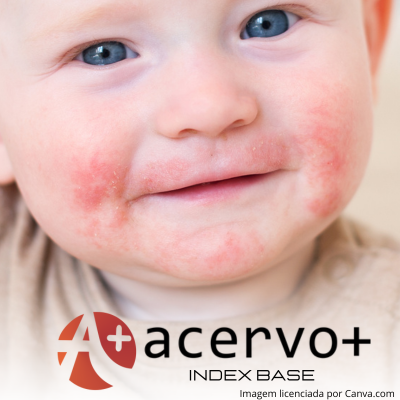A influência da microbiota cutânea na dermatite atópica infantil
##plugins.themes.bootstrap3.article.main##
Resumo
Objetivo: Analisar a influência da microbiota cutânea na dermatite atópica infantil. Revisão bibliográfica: Dermatite atópica (DA) é uma inflamação cutânea que resulta no aparecimento de lesões e coceira na pele, podendo afetar indivíduos de diferentes faixas etárias, em especial crianças. Em função da constante exposição ao meio externo, a epiderme possui alguns mecanismos que atuam como uma barreira natural de proteção, a exemplo da microbiota cutânea. Constituído por microrganismos comensais, este microbioma sofre a influência de diversos fatores que, uma vez em desequilíbrio, transformam a região suscetível ao surgimento de dermatite atópica. Dessa forma, estudos comprovam que pacientes com DA apresentam certo domínio na colonização cutânea por Staphylococcus aureus, atestando que existe uma correspondência entre o grau de intensidade da inflamação com a quantidade de bactérias nas lesões. Considerações finais: A falta de exposição da microbiota cutânea a uma diversidade microbiana na infância gera uma baixa tolerância imunológica que pode influenciar no desenvolvimento da dermatite atópica em pacientes pediátricos.
##plugins.themes.bootstrap3.article.details##
Copyright © | Todos os direitos reservados.
A revista detém os direitos autorais exclusivos de publicação deste artigo nos termos da lei 9610/98.
Reprodução parcial
É livre o uso de partes do texto, figuras e questionário do artigo, sendo obrigatória a citação dos autores e revista.
Reprodução total
É expressamente proibida, devendo ser autorizada pela revista.
Referências
2. ALIAGA GLC, et al. Adverse effects of using cyclosporine in patients with severe atopic dermatitis. Arquivos de Asma, Alergia e Imunologia, 2020; 4.
3. EDSLEV S, et al. Skin microbiome in atopic dermatitis. Acta dermato-venereologica, 2020;100(12):00164.
4. EICHENFIELD LF, et al. Recent developments and advances in atopic dermatitis: A focus on epidemiology, pathophysiology, and treatment in the pediatric setting. Paediatric drugs,2022;24(4): 293–305.
5. DELIOS S, et al. Probiotics in the prevention and treatment of atopic dermatitis. Pediatric allergy and immunology: official publication of the European Society of Pediatric Allergy and Immunology, 2020; 31(26): 43–45.
6. FALCON MM, et al. Síndrome da pele vermelha: a consequência do uso crônico de corticoides tópicos. Cuadernos de Educación y Desarrollo, 2024; 16(2).
7. FANG Z, et al. Gut Microbiota, probiotics, and their interactions in prevention and treatment of atopic dermatitis: A review. Frontiers in Immunology, 2021; 12:720393.
8. HALLING AS, et al. Reduced skin microbiome diversity in infancy is associated with increased risk of atopic dermatitis in high-risk children. The Journal of Investigative Dermatology, 2023; 143(10):2030-2038.e6.
9. KIM J, et al. Alterations of epidermal lipid profiles and skin microbiome in children with atopic dermatitis. Allergy, Asthma & Immunology Research, 2023; 15(2):186–200.
10. LARA MF, et al. Os probióticos podem desempenhar um papel na prevenção e tratamento da dermatite atópica pediátrica. Revista Médica de Minas Gerais, 2015; 25.
11. LI H, et al. Update on the pathogenesis and therapy of atopic dermatitis. Clinical reviews in allergy & immunology, 2021;61(3):324–338.
12. LIU Y, et al. Distinct skin Microbiota imbalance and responses to clinical treatment in children with atopic dermatitis. Frontiers in cellular and infection microbiology,2020;10:336.
13. QUADROS BF, et al. Dermatite Atópica: perspectivas atuais em diagnóstico, manejo terapêutico, controle de recorrências e prevenção de complicações. Zenodo, 2024.
14. OLIVEIRA AMF, et al. Atopic dermatitis pediatric patients show high rates of nasal and intestinal colonization by methicillin-resistant Staphylococcus aureus and coagulase-negative staphylococci. BMC microbiology, 2024; 24(1): 42.
15. RUSU E, et al. Prebiotics and probiotics in atopic dermatitis. Experimental and therapeutic medicine, 2019.
16. SIVIERI K, et al. Microbiota da pele: Novos desafios. Arquivos Catarinenses de Medicina, 2021;50(1): 93–112.
17. SUN Z, et al. A microbiome-based index for assessing skin health and treatment effects for atopic dermatitis in children. MSystems, 2019;4 (4).
18. STACEY SK e MCELENEY M. Corticosteróides tópicos: escolha e aplicação. American Family Physician, 2021; 103(6):337–343.
19. SROKA TJ e TRZECIAK M. Molecular mechanisms of atopic dermatitis pathogenesis. International Journal of Molecular Sciences, 2021; 22(8):4130.
20. SHI B, et al. The skin microbiome is different in pediatric versus adult atopic dermatitis. The Journal of Allergy and Clinical Immunology, 2016; 138(4):1233–1236.
21. THAM EH, et al. The skin microbiome in pediatric atopic dermatitis and food allergy. Allergy, 2024; 79(6):1470–1484.
22. VANDEPUTTE D, et al. Probióticos e prebióticos na prevenção e tratamento de doenças em lactentes e crianças. Jornal de Pediatria, 2011; 87(4):292–300.
23. WRZEŚNIEWSKA M, et al. The role of the Microbiota in the pathogenesis and treatment of atopic dermatitis-A literature review. International journal of molecular sciences, 2024;25(12):6539.
24. XUE X, et al. Efficacy of probiotics in pediatric atopic dermatitis: A systematic review and meta-analysis. Clinical and translational allergy, 2023;13(7): e12283.

